Key Points
- Your spending needs in retirement should be the first thing to consider when formulating a strategy for generating income.
- There are a number of ways to generate income in retirement, with pros and cons for each.
- Inflation could be a big factor in your plan, depending on the source of most of your income.
Do you know how you compare to the average income in retirement in the U.S.? What kind of income will your retirement plan be able to generate once you retire?
That's a sort of inverted way of asking about your retirement spending needs. Most would-be retirees these days, in our largely post-pension world, accumulate wealth via tax-deferred or tax-advantaged investment accounts. In doing their calculations about how and when they'll be able to retire, they start (or at least should start) with their spending needs.
If you'll mostly be depending on investment accounts, it's a matter of estimating how much those accounts can reasonably be expected to grow in value between now and retirement, and then estimating how much the portfolio will be able to provide, safely, once you are retired. By safely, we are mostly referring to sequence-of-returns risk here. You might be drawing down on your retirement accounts using what feels like a reasonably safe withdrawal rate, but if you're hit with a recession, especially early in your retirement years, you might need to rethink the whole thing.
Those with defined benefit plans--such as people with pensions--don't have to worry about this possibility as much. They know what they're going to receive, they know if it is indexed to inflation or not (a big issue lately, for obvious reasons), and can plan accordingly.
They also don't need to accumulate as much in assets before retiring. Think of it this way: Say a couple is fortunate enough to have $50,000 a year in pension income. That's arguably almost the equivalent of having a $1 million investment portfolio if you assume that portfolio can generate 5% returns annually (a reasonably conservative assumption) or a $1.25 million portfolio if you assume 4% annual returns. On top of that, there's no need to worry about fluctuation in its value the way you would need to with an investment portfolio.
In practice, many people will have a hybrid of both investments and some kind of defined benefit, if you consider Social Security a defined benefit. According to the Social Security Administration, Social Security payments account for about one third of the income for people who are retired. In 2021, the average monthly income from Social Security was $1,543. In 2022, the average was $1,657.
The Average Income in Retirement
According to the US Census Bureau, the median income in retirement for those 65 and older was $47,620 in 2021, with the mean at $75,254. (A quick math refresher: Median is the middle value when the numbers are listed from least to most, while average is calculated by adding up all the values and dividing that sum by the number of entries.)
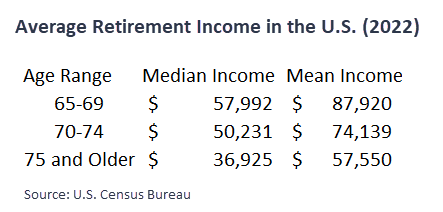
There are a number of ways a retiree might get to retirement income levels that will work for them. Let's take a look at a few, using a hypothetical 47-year-old couple looking to retire when they turn 65. We'll vary a number of inputs in their plan, but a few things will stay steady: Their current age, retirement age, projected spending in retirement ($75,000), projected goals and one-off expenses in retirement (which vary by year), and projected Social Security income between them ($25,000).
Mostly Investment Accounts
In the first variation of their plan, our couple has amassed an impressive investment portfolio of about $2.2 million, mostly in value stocks. Things look pretty great for them on a straight-line basis, with that value growing to $3.6 million at their retirement--and a staggering $8 million at the end of their plan:
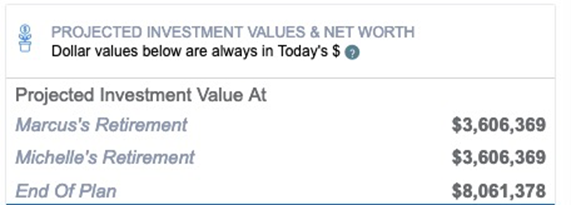
But straight-line results only tell part of the story, and that story does not include bear markets, recessions, asset class correlations, and a lot else. That's what Monte Carlo is for, and their Monte Carlo results tell a different story:
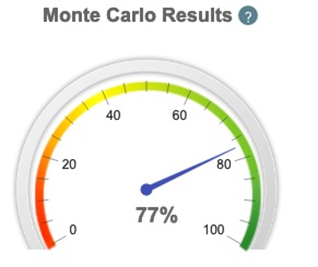
That's not terrible, but it's also not great. There are some things we could do to get that number higher. But what's more interesting is the projected variability in their returns:
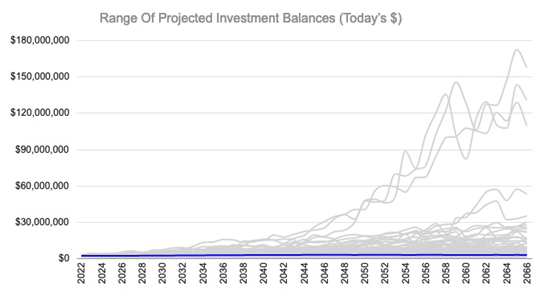
The results range from $0 to more than $150 million! That's the thing about investments--the variability in returns, even with mostly relatively conservative investments like value stocks, can be huge.
Mostly Defined Benefit
If we instead structure their plan in such a way that they're mostly dependent on defined benefit income during retirement, we expect things will look a lot different.
Under the Mostly-Investment-Account version, by the time they retire, their portfolio is expected to be in the $3.6 million range, and is projected to generate a lot of cash--in the $250,000 range annually.
If we drastically reduce their current portfolio's value from $2.2 million to about $300,000, but give each of them $35,000 annual pensions, indexed to inflation, look what happens:
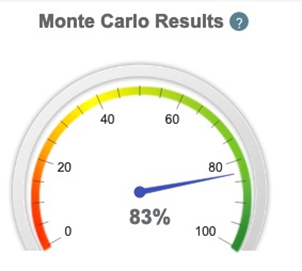
Their adjusted income, thanks to those pensions, is nowhere near the $250K they might have been able to generate with an investment portfolio--and yet their Monte Carlo results went up. This is the beauty of steady income: The chance of it not being there is far lower than with an investment portfolio. They're not going to have that 1-in-1,000 chance of having $150 million when they die (The Monte Carlo results now show their highest potential portfolio ending value of about $4.5 million), but they can feel more certain that they'll be able to cover their expenses in retirement.
There are other ways to increase income in retirement that don't rely on pensions, and we've written about several of them. Annuities are one way to do so. Dividend-oriented portfolios are another. The key is reducing volatility while increasing cash flow. Easier said than done, but it's quite possible.
And Speaking of Inflation
The scourge of inflation is on every investor's mind lately, and even more so for retirees. Fixed income is great, but if it's not indexed to inflation, its purchasing power is diminished over time. Regardless of whether you're largely dependent on stocks or on defined benefits, now is the time to stress test your plan. WealthTrace’s retirement planning software allows you to vary inflation rates by year, like this:
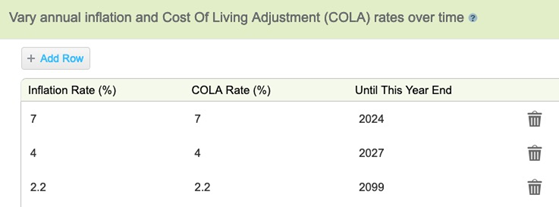
Different Ways of Achieving Success
Your method of generating retirement income is probably incidental to your career path. That is, if you've worked in government or some other form of public service, you might have a pension. At a university, you might have been contributing to a 403(b) plan. Regardless of your career moves, you might have been contributing to IRA accounts along the way. However you make retirement happen, you'll want to know not just how your income compares to the averages, but what factors (like inflation or volatility) to keep an eye on. WealthTrace can help, no matter what your sources of retirement income are.
Do you know how much income you will need to retire comfortably? Sign up for a free trial of WealthTrace to find out.